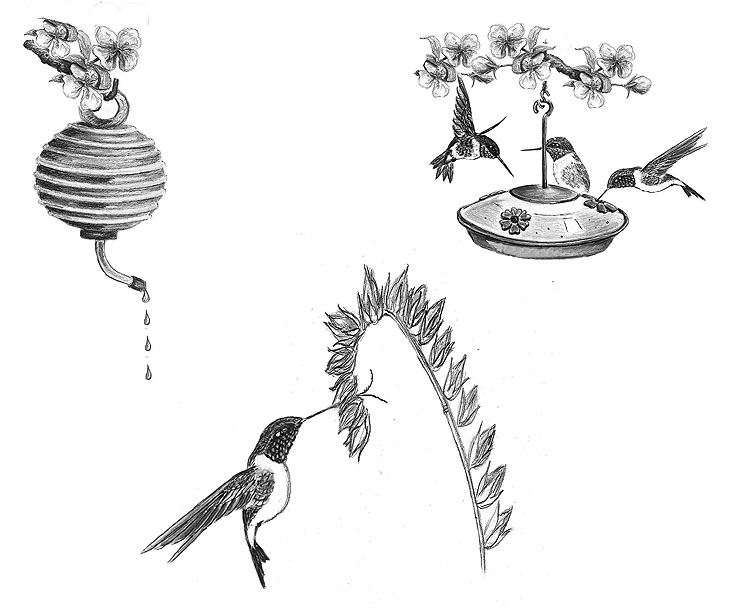
Dear Bird Folks,
Do they make any hummingbird feeders that actually don’t leak?
– David, Brewster, MA
Yes, David,
There are indeed hummingbird feeders that don’t leak. They’ve been around for at least forty years, and probably longer. Dripping feeders are a thing of the past. Where do you shop for your feeders, a time capsule? FYI: I should point out that David is a friend, a brilliant naturalist who knows way more about birds than I ever will. But he also likes to do things old school. His idea of discovering cutting-edge technology is taking a trip to Plimoth Plantation, which is where he probably bought his last hummingbird feeder.
Most manufacturers have long ago stopped producing dripping hummingbird feeders. Today, these annoying feeders are most often found at local craft fairs. Don’t get me wrong; I love craft fairs. There are always cool things to see. Oh, sure, you’ll have to sort through wind chimes made from beer cans and toilet seats turned into clocks, but most of the stuff is pretty impressive. However, there is one item I wish craft people would stop making. I’m talking about the dreaded upside-down bottle with a stopper/tube stuffed into the bottom, labeled “hummingbird feeder.” These bottle feeders are often beautiful and even though the birds will use them, they are also prone to leaking. And when I say “prone,” I mean every one ever made has leaked…at least according to the people who complain to me about them. Why do they drip so much? I’m not Mr. Wizard, but I’d bet it has to do with changes in air pressure. As the sun heats the bottle, the air inside expands and pushes out the sugar water. There are many feeders that don’t have this issue, but they aren’t nearly as attractive as the fancy bottle kind and thus won’t likely to sell well at craft fairs…unless they’re displayed alongside the toilet seat clocks. Then maybe.
I find the best hummingbird feeders are the simple clear plastic bowls with red covers. The shallow bowl holds the sweet liquid and just like a soup or cereal bowl, it’s completely leak-free. Also, like a cereal bowl, this type of feeder is super easy to clean. Just give it a quick rinse with hot water and you are done. With the other feeder style you’ll have to invest in a bottlebrush in order get through the narrow opening. And good luck trying to clean the tube and stopper. You’ll have to use an old timey pipe cleaner and I don’t even know if they still make pipe cleaners. (But I’d bet David knows.)
Because the bottle-style feeder allows the nectar to flow to the very end of the feeder tube, it’s pretty obvious where the birds feed from. Things aren’t quite as apparent with the bowl feeder. Here the liquid sits well below the cover, causing customers to ask how the birds are able to reach the food. It’s easy. Hummingbirds have really long beaks, but they don’t use their beaks to suck up their food; their beaks are not straws. Instead, they extend their equally long tongues into the feeder (or flower) and essentially lap up the nectar like a dog (only without all the slobbering). When a dog drinks from a water bowl, it curls its tongue backwards and actually scoops up the water and lifts it up into its mouth. Hummingbirds do things differently, and earlier this summer I discovered just how differently.
I was sitting on my back deck, having breakfast when a Ruby-throated Hummingbird arrived and began feeding on my wife’s flowers. The early morning sun was perfect, so I started photographing the action. Over the years, I’ve taken a zillion or so photos of hummingbirds, but one of the photos I took on this day had a surprise. I discovered (although I’m sure David already knew this) that hummingbirds have forked tongues, much like a snake…or a politician. Each “fork” is covered in tiny hair-like extensions called “lamellae.” When feeding, the bird will flick its tongue in and out several times per second, capturing nectar with each flick. The bird on this day had pushed its beak totally through a blossom, causing its tongue to shoot out the other side, exposing the fork. I was so excited by my dramatic photo, I ran over and showed my wife, who responded by saying, “Hmm.” When it comes to birds, that’s as excited as she gets.
While I’m on the topic of bottle-style hummingbird feeders, here’s another reason not to buy one. The bottle acts as a reservoir, holding the sugar water and replenishing the feeding area as the food is consumed. This makes the nectar readily available for the birds…and the bees. We receive a lot of complaints about bees and wasps dominating this kind of feeder. Conversely, the flat bowl feeders store the food supply well below the cover and out of the reach of bees and their shorter, fork-less tongues.
If you check the calendar, David, you’ll quickly discover that it’s the 21st Century. While this current century has had its share of problems and disappointments, the availability of good, leak-proof hummingbird feeders isn’t one of them. They are fairly inexpensive and are available everywhere. Well, everywhere except for maybe Plimoth Plantation. You should check for them, David, the next time you go there to pick up a new butter churn.